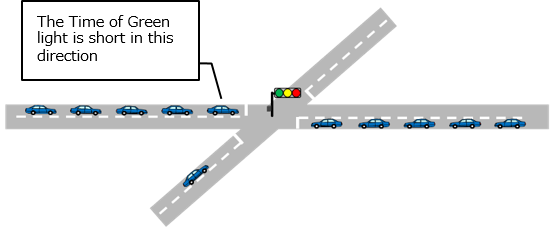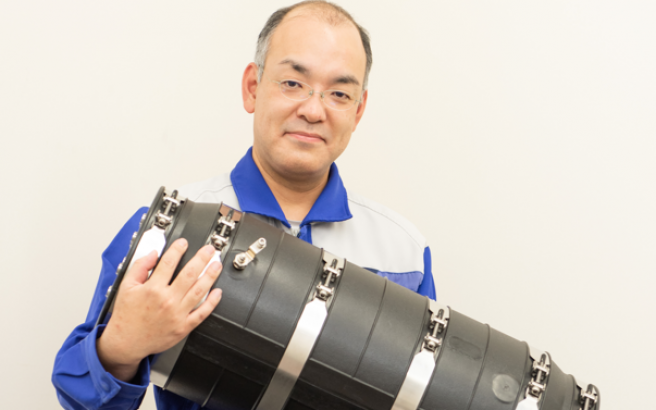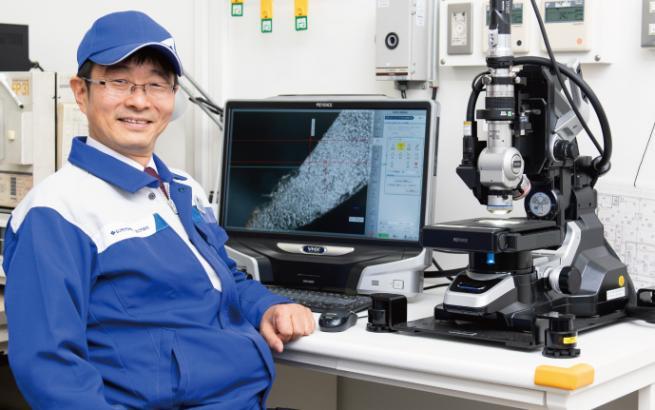Detecting Congested Intersections Using vehicle Probe Data to Achieve Smooth Traffic Flow

Detection of Congested Intersections Using Car-Probe Data
Shintaro Matsumoto,
Information Network R&D Center
When you are driving, the road you are traveling on is heavily congested, but you see no cars passing on the crossing road even when the traffic light turns green...I believe that not a few people have experienced this frustrating situation. We call this situation “unbalanced congestion.”
To solve this problem, we focused on vehicle driving data that can be collected from smartphones and connected cars. The data, which are called “vehicle probe data,” can be used to know the positions and average speed of traveling vehicles. We have developed a technique to detect congested intersections by analyzing the collected vehicle probe data in combination with intersection data created from publicly available map data.
Mechanism of unbalanced congestion at intersections— Caused by the mismatch between pre-set green time and actual traffic volume
The green time at an intersection is determined by the traffic volume on each road crossing at the intersection. If the traffic volume is even between crossing roads, the green time should be also even, but most intersections have a difference in traffic volume between crossing roads and the difference changes depending on the time of day and day of the week. For optimal traffic signal control, it is first necessary to grasp the traffic conditions, which are usually measured with vehicle sensors installed above roads.
However, due to the costs required for the installation and maintenance of vehicle sensors, many intersections remain without them. Traffic signals at intersections without these sensors have pre-set control settings for each time of day and day of the week, but their control cannot adapt to changes in traffic demand over a longer period of time. This is one of the causes of traffic congestion, but in order to change the signal control setting, someone must investigate traffic conditions on site, which takes a huge amount of time and effort.

Fig. 1. Overview of an intersection congested on one side
Enabling the remote detection of intersections with unbalanced congestion
The technique we have developed provides a solution to this problem with traffic signal control. A large amount of vehicle probe data is currently being collected worldwide. By using the data, namely, using each traveling vehicle as an information source, it becomes possible to find congested intersections without vehicle sensors. In this way, intersections that have problems with their traffic signal control can be detected remotely and efficiently without conducting on-site surveys.
The goal is to create a transportation system that reduces CO2 emissions
Our group is also developing a technique to calculate traffic signal control that matches actual traffic conditions using collected vehicle probe data. By combining this technique with the intersection detection technique, we can detect intersections congested due to inappropriate traffic signal control and correct it in one go.

Fig. 2. Conceptual scheme of traffic signal control using probe data
Through these developments, we aim to achieve a transportation system that can eliminate congestion and thereby reduce CO2 emissions. As an overseas project in Bangkok, Thailand, we are working on demonstration experiments and joint research on transportation systems using vehicle probe data. We would like to make proposals to customers around the world.
Rather than considering what we can do with the technology we have developed, we have constantly been asking ourselves what benefits the technology can provide and what kind of business it can create. Instead of just concentrating on the task at hand, we are working on development while keeping in mind the purpose of the task before taking action. We believe that this will lead to the creation of a safe, secure, and comfortable society.

SUMITOMO ELECTRIC TECHNICAL REVIEW
A journal of technical papers explaining the Sumitomo Electric’s technologies. Technical papers are available in PDF format.
Learn more


